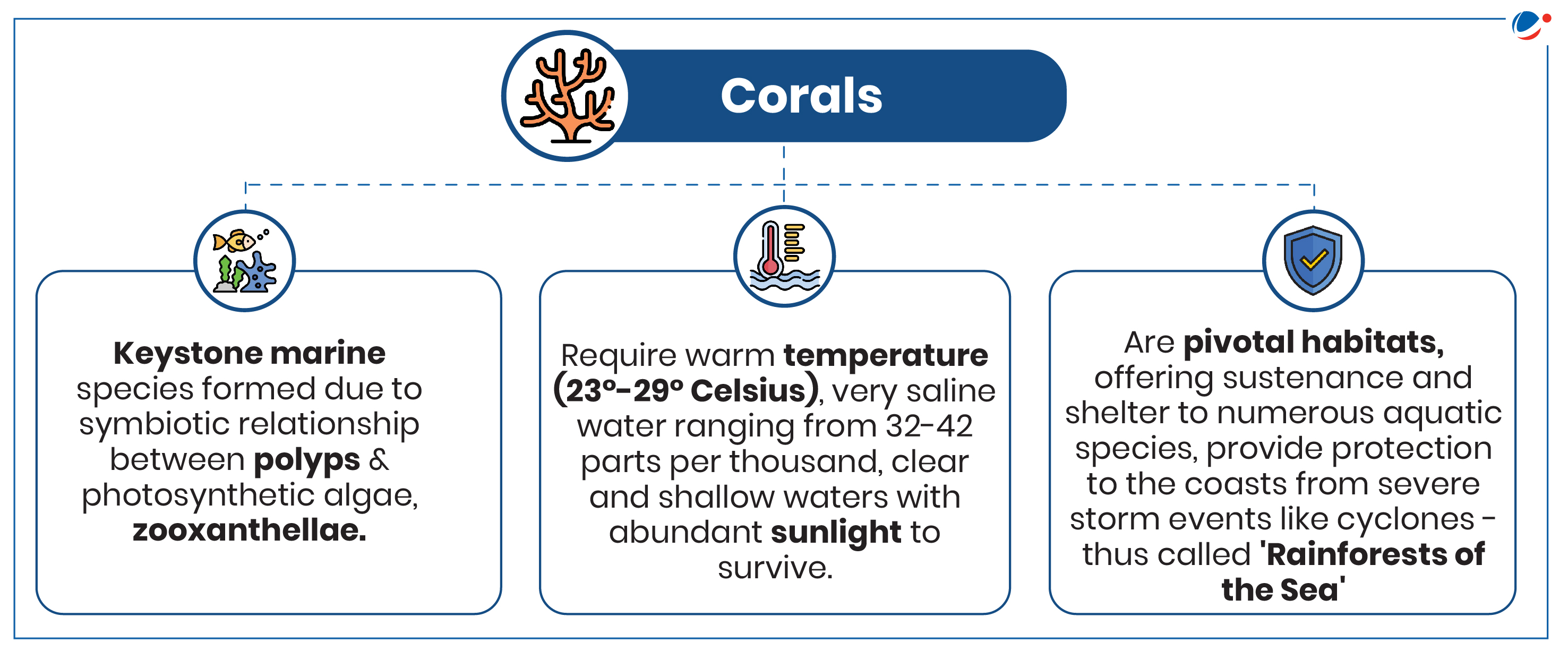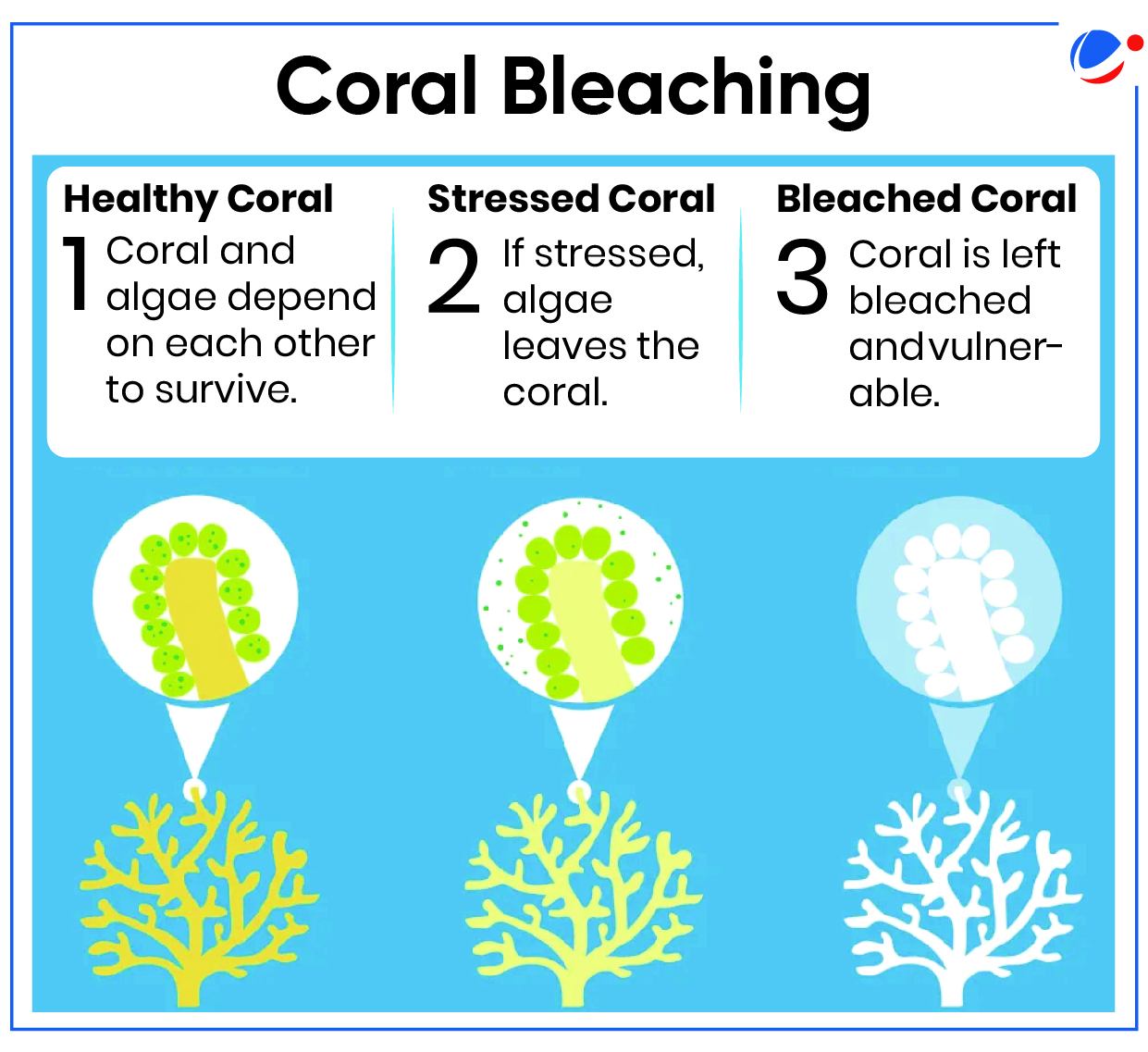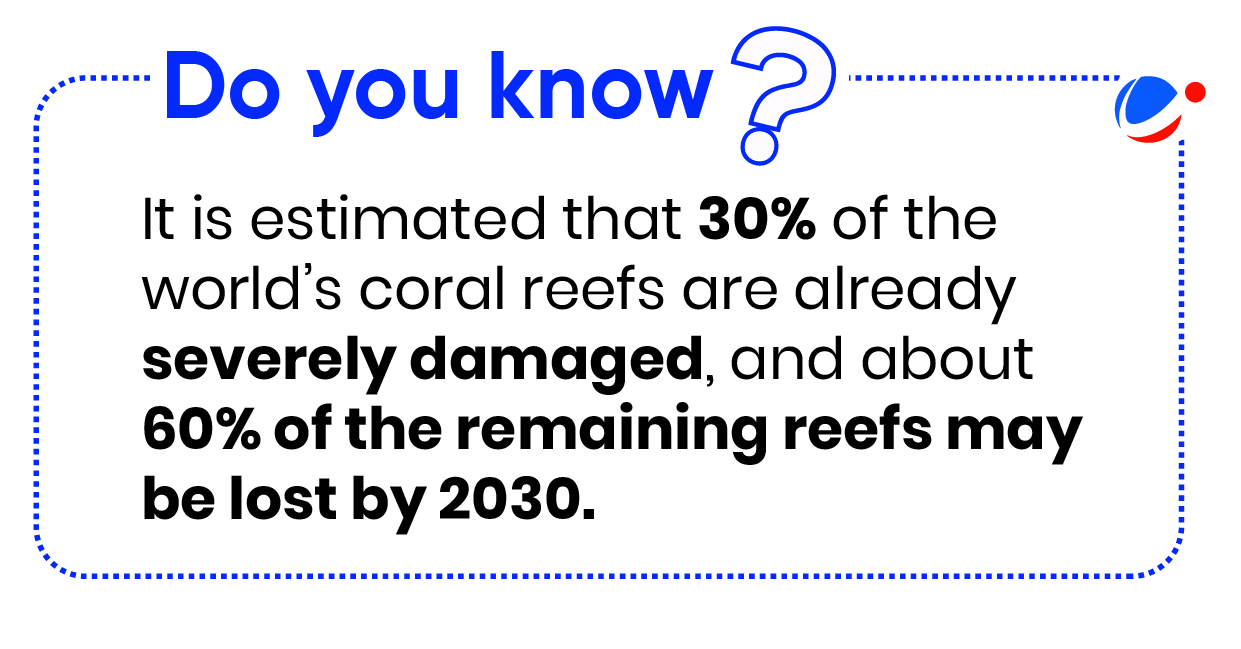Why in the news?
Recently, widespread coral bleaching has been seen along the Indian coast largely affecting Lakshadweep, Gulf of Munnar, Palk Bay and Andaman and Nicobar Islands.

More about the instances of bleaching
- Lakshadweep Islands: The Islands are made up of coral atolls, which are at significant risk due to coral bleaching.
- Bleaching is seen across almost all species like Acropora muricata and Porites cylindrica in the Kavaratti Islands.
- Species that are often more stress-tolerant, such as Porites lutea and Pavona varians have also begun to bleach in Lakshadweep.
- Gulf of Mannar: The coral reefs in the Gulf of Mannar have deteriorated owing to a combination of climatic and anthropogenic factors.
- The live coral cover in the Gulf of Mannar decreased from 37% to 27.3% between 2005 and 2021.
- Palk Bay: The average coral cover in Palk Bay was at 30.8% in 2007, but it dropped to 18.7% by 2019.
- Goa: Coral bleaching has started but is limited to one species, Goniopora.

What is coral bleaching?

- Sustained increase in Sea Surface Temperature (SST) causes the zooxanthellae, which provide pigmentation and 90 per cent of the corals' nutritional needs, to leave their hosts, resulting in the whitening of corals, known as 'coral bleaching'.
- Global mass coral bleaching events have been reported in 1998, 2010, 2014-2017, according to the United States National Oceanic and Atmospheric Administration.
- Presently, 2023-2024 is being named as the fourth global mass coral bleaching event.
Primary reasons for coral bleaching
- Increasing Sea Surface Temperatures: Rising greenhouse gases trap the radiated heat in the atmosphere, excess of which is absorbed by the oceans, leading to increased SST.
- In tropical regions, mean sea surface temperatures (SSTs) have risen by almost 1°C over the past 100 years and are currently increasing at a rate of 1-2°C per century.
- Marine heatwaves: They lead to exponential rise in SST which leads to expulsion of zooxanthellae, leading to coral bleaching.
- An underwater survey showed that 85% of the corals in the Gulf of Mannar near the Tamil Nadu coast got bleached after the marine heatwave in 2020.
- El Nino: Heating of certain areas above the maximum mean temperature due to El Nino causes stress on the corals and leads to bleaching.
- Shifting ocean currents: The changes in heating patterns of the land and sea, salinity of ocean water and wind patterns result in shifting ocean currents. This adds to the changes in SST which impacts the survival of corals.
- Ocean acidification also leads to the expulsion of the zooxanthellae, causing coral bleaching.
- Sedimentation: Bottom trawling and dumping of waste along the coasts lead to sedimentation which hinders the photosynthesis of the zooxanthellae, thus causing coral bleaching.
Other reasons
|
Initiatives taken for coral conservation in India
Acts like the Coastal Regulation Zone (CRZ) Notification of 1991 issued under the broad Environment Protection Act, 1986 ensure the overall protection of coral reefs in India.
- Eco-development activities by the Gulf of Mannar Biosphere Reserve Trust: These initiatives have empowered the local fishing communities, providing them with additional or alternative sources of income.
- Such efforts have helped to reduce the pressure on marine resources, particularly on the coral reefs, contributing significantly to their conservation and sustainability.
- Coral Reef Recovery Project-Mithapur (Gulf of Kachchh and Gujarat's Marine National Park): Launched in 2008 by Wildlife Trust of India (WTI) and Gujarat Forest Department, it envisions the creation of a model public-private-managed coral ecosystem of international standards.
- It aims to use global benchmarks to restore degraded reefs through activities including coral transplantation and natural recruitment.
- Zoological Survey of India (ZSI) with the Gujarat Forest Department successfully restored coral reefs in the Gulf of Kachchh.
- Restoration of a branching coral species (staghorn corals) that had gone extinct about 10,000 years ago to the Gulf of Kachchh was successful.

Way forward: Countering coral bleaching
- Multilateral cooperation in policymaking
- International Coral Reef Initiative (ICRI): It is a global informal partnership between Nations and organizations which strives to preserve coral reefs and related ecosystems around the world.
- Founded in 1994 at the First Conference of the Parties of the Convention on Biological Diversity.
- India is a member of the ICRI.
- World Coral Conservatory project: It creates a bank of corals in aquariums across Europe that could be used to repopulate wild coral reefs if they succumb to the stress of climate change or pollution.
- International Coral Reef Initiative (ICRI): It is a global informal partnership between Nations and organizations which strives to preserve coral reefs and related ecosystems around the world.
- Use of biotechnology:
- Biorock technology: It is an innovative mineral accretion technology used to produce natural building materials in the sea which aids in coral restoration. E.g., Used in the Gulf of Kachchh Coral restoration.
- Super corals: Ex-situ breeding of high temperature-resistant corals with the help of the process known as 'human-assisted evolution'.
- Long-term structural efforts:
- Incorporating sustainability by reducing carbon footprint and marine pollution with more effective waste management.
- Building resilient coastal communities through awareness and training. Thus, enabling them to undertake sustainable fishing and other conservation activities.



